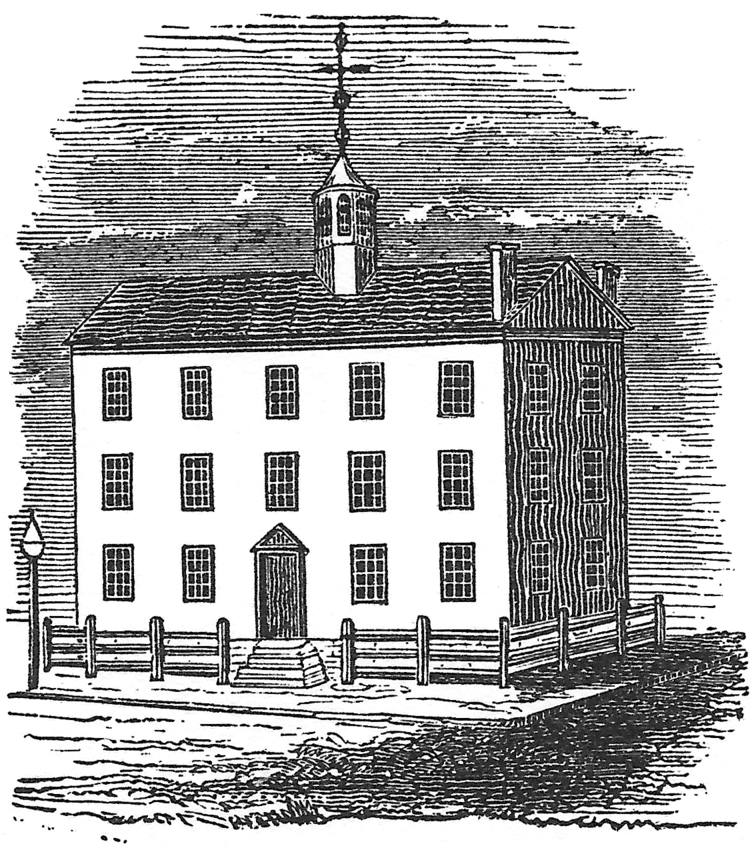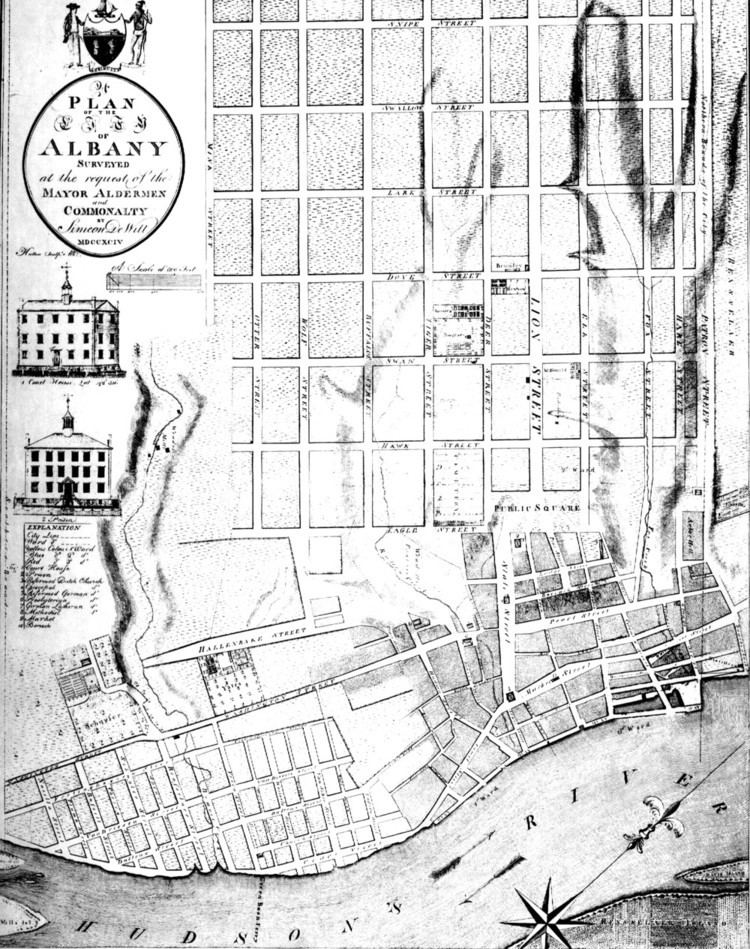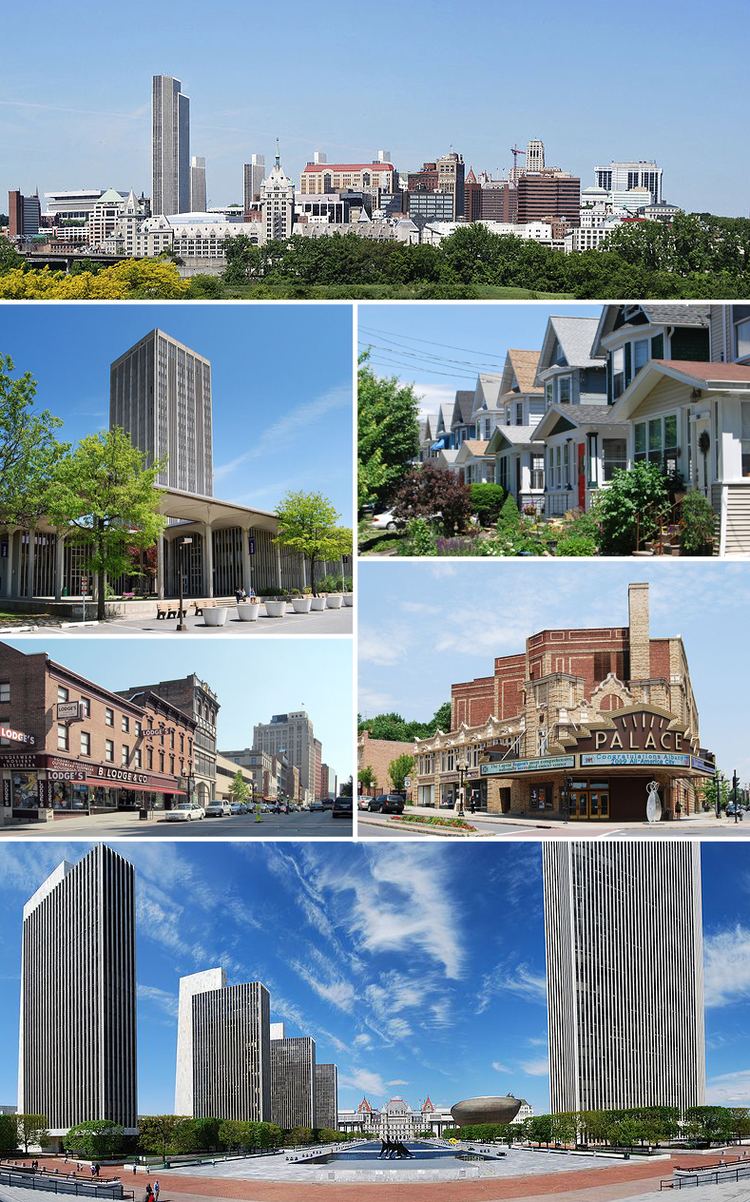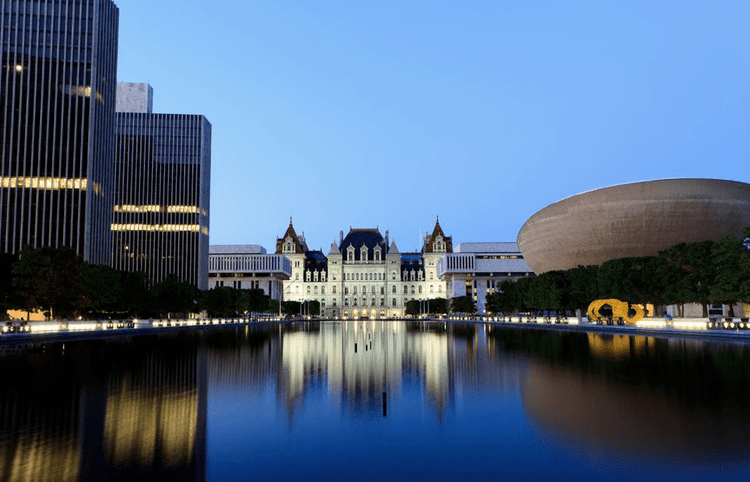Country United States Population 98,424 (2013) Unemployment rate 5.0% (Dec 2014) Area - land21.4 sq mi | ||
Recent posts on Google+ Points of interest New York State Museum, Empire State Plaza, New York State Capitol, The Times Union Center, USS Slater (DE-766) Colleges and Universities University at Albany - SUNY, Albany Medical College, The College of Saint Rose, Albany Law School, Albany College of Pharmacy and Health Sciences | ||
Albany ( AWL-b?-nee) is the state capital of New York and the seat of Albany County. Roughly 135 miles (220 km) north of the City of New York, Albany developed on the west bank of the Hudson River, about 10 miles (16 km) south of its confluence with the Mohawk River. The population of the City of Albany was 97,856 according to the 2010 census. Albany has close ties with the nearby cities of Troy, across the river; Schenectady to the west on the Mohawk River, and Saratoga Springs to the north, forming a region called the Capital District. This is comprised mostly of the Albany-Schenectady-Troy Metropolitan Statistical Area (MSA). The areas 2010 population was 870,716, the 4th-largest MSA in New York and the 58th largest in the country.
Contents
- Map of Albany New York
- The sights of albany ny part 1
- Quick tour of albany new york
- History
- Geography
- Culture
- Economy
- Festivals
- Museums and historic sites
- Food delivery albany ny
- Breakfast albany ny farmer boy diner and restaurant 5184562243
- What is a whole food multi vitamin albany ny
- References
Map of Albany, New York
The first European settlement in this area was by Dutch colonists who built Fort Nassau in 1614 and Fort Orange in 1624. They formed successful relations with both the Mahican and the Mohawk people, two major Native American nations. The fur trade attracted settlers who founded a village called Beverwijck near Fort Orange. In 1664 the English took over and renamed the city as Albany, in honor of the then Duke of Albany, the future James II of England and James VII of Scotland. The city was officially chartered in 1686 under English rule. It became the capital of New York State in 1797 following the United States gaining independence in the American Revolutionary War. Albany is one of the oldest surviving settlements of the original British thirteen colonies, and the longest continuously chartered city in the United States. Its charter is possibly the longest-running instrument of municipal government in the Western Hemisphere.
The sights of albany ny part 1
During the late 18th century and throughout most of the 19th, Albany was a center of trade and transportation. It is located on the north end of the navigable Hudson River, was the original eastern terminus of the Erie Canal connecting to the Great Lakes, and was home to some of the earliest railroad systems in the world. Albanys main exports at the time were beer, lumber, published works, and ironworks. Beginning in 1810, Albany was one of the ten most populous cities in the United States, a distinction that it held until the 1860 census.
Quick tour of albany new york
Albany is one of the first cities in the world to have installed public water mains, sewer lines, natural gas lines and electricity, infrastructure and utilities that attracted and supported substantial new industry to the city and surrounding area during the 19th century.
In the 20th century, the city opened one of the first commercial airports in the world, the precursor of todays Albany International Airport. During the 1920s a powerful political machine controlled by the Democratic Party arose in the state capital, connected to politics in New York City as well.
The citys skyline changed in the 1960s with the construction of office towers around the Empire State Plaza and at the uptown campus of SUNY Albany, mainly under the direction of Governor Nelson Rockefeller. While Albany experienced a decline in its population due to urban sprawl, many of its historic neighborhoods were saved from destruction through the policies of Mayor Erastus Corning 2nd, the longest-serving mayor of any city in the United States. In the early 21st century, the city has experienced growth in the high-technology industry, with great strides in the nanotechnology sector.
Albany has been a center of higher education for over a century, with much of the remainder of its economy dependent on state government and health care services. The city has rebounded from the urban decline of the 1970s and 1980s, with noticeable development taking place in the citys downtown and midtown neighborhoods. Albany is known for its extensive history, culture, architecture, and institutions of higher education. The city is home to the mother churches of two Christian dioceses, as well as the oldest Christian congregation in Upstate New York. Albany won the All-America City Award in both 1991 and 2009.
History

Albany is one of the oldest surviving European settlements from the original thirteen colonies and the longest continuously chartered city in the United States. The Hudson River area was originally inhabited by Algonquian-speaking Mohican (Mahican), who called it Pempotowwuthut-Muhhcanneuw, meaning "the fireplace of the Mohican nation." Based to the west along the Mohawk River, the Iroquoian-speaking Mohawk referred to it as it Sche-negh-ta-da, or "through the pine woods". It is likely that the Albany area was visited by European fur traders, perhaps as early as 1540, but the extent and duration of those visits has not been determined

Permanent European claims began when Englishman Henry Hudson, exploring for the Dutch East India Company on the Half Moon (Dutch: ), reached the area in 1609, claiming it for the United Netherlands. In 1614, Hendrick Christiaensen built Fort Nassau, a fur-trading post and the first documented European structure in present-day Albany. Commencement of the fur trade provoked hostility from the French colony in Canada and amongst the natives, all of whom vied to control the trade. In 1618, a flood ruined the fort on Castle Island, but it was rebuilt in 1624 as Fort Orange. Both forts were named in honor of the Dutch royal House of Orange-Nassau. Fort Orange and the surrounding area were incorporated as the village of Beverwijck (English: Beaver District) in 1652. In these early decades of trade, the Dutch, Mohican and Mohawk developed relations that differed in accordance with their three cultures.
When New Netherland was captured by the English in 1664, the name Beverwijck was changed to Albany, in honor of the Duke of Albany (later James II of England and James VII of Scotland). Duke of Albany was a Scottish title given since 1398, generally to a younger son of the King of Scots. The name is ultimately derived from Alba, the Gaelic name for Scotland. The Dutch briefly regained Albany in August 1673 and renamed the city Willemstadt; the English took permanent possession with the Treaty of Westminster (1674). On November 1, 1683, the Province of New York was split into counties, with Albany County being the largest. At that time the county included all of present New York State north of Dutchess and Ulster Counties in addition to present-day Bennington County, Vermont, theoretically stretching west to the Pacific Ocean; the city of Albany became the county seat. Albany was formally chartered as a municipality by provincial Governor Thomas Dongan on July 22, 1686. The Dongan Charter was virtually identical in content to the charter awarded to the city of New York three months earlier. Dongan created Albany as a strip of land 1 mile (1.6 km) wide and 16 miles (26 km) long. Over the years Albany would lose much of the land to the west and annex land to the north and south. At this point, Albany had a population of about 500 people.
In 1754, representatives of seven British North American colonies met in the Stadt Huys, Albanys city hall, for the Albany Congress; Benjamin Franklin of Pennsylvania presented the Albany Plan of Union there, which was the first formal proposal to unite the colonies. Although it was never adopted by Parliament, it was an important precursor to the United States Constitution. The same year, the French and Indian War, the fourth in a series of wars dating back to 1689, began; it ended in 1763 with French defeat, resolving a situation that had been a constant threat to Albany and held back its growth. In 1775, with the colonies in the midst of the Revolutionary War, the Stadt Huys became home to the Albany Committee of Correspondence (the political arm of the local revolutionary movement), which took over operation of Albanys government and eventually expanded its power to control all of Albany County. Tories and prisoners of war were often jailed in the Stadt Huys alongside common criminals. In 1776, Albany native Philip Livingston signed the Declaration of Independence at Independence Hall in Philadelphia.
During and after the Revolutionary War, Albany County saw a great increase in real estate transactions. After Horatio Gates win over John Burgoyne at Saratoga in 1777, the upper Hudson Valley was generally at peace as the war raged on elsewhere. Prosperity was soon seen all over Upstate New York. Migrants from Vermont and Connecticut began flowing in, noting the advantages of living on the Hudson and trading at Albany, while being only a few days sail from New York City. Albany reported a population of 3,498 in the first national census in 1790, an increase of almost 700% since its chartering. In 1797, the state capital of New York was moved permanently to Albany. From statehood to this date, the Legislature had frequently moved the state capital between Albany, Kingston, Hurley, Poughkeepsie, and the city of New York. Albany is the tenth-oldest state capital in the United States, but only the second-oldest state capital that is a city, after Santa Fe, New Mexico.
Geography
Albany is located about 150 miles (240 km) north of New York City on the Hudson River. It has a total area of 21.8 square miles (56 km2), of which 21.4 square miles (55 km2) is land and 0.4 square miles (1.0 km2) (1.8%) is water. The city is bordered on the north by the town of Colonie (along with the village of Menands), on the west by the town of Guilderland, and on the south by the town of Bethlehem. The Hudson River represents the citys eastern border. Patroon Creek, along the northern border, and the Normans Kill, along the southern border, are the two major streams in the city. The former Foxes Creek, Beaver Kill, and Rutten Kill still exist, but were diverted underground in the 19th century. There are four lakes within city limits: Buckingham Lake; Rensselaer Lake at the mouth of the Patroon Creek; Tivoli Lake, which was formed as a reservoir and once connected to the Patroon Creek; and Washington Park Lake, which was formed by damming the Beaver Kill.
The highest natural point in Albany is USGS benchmark near the Loudonville Reservoir off Birch Hill Road, at 378 feet (115 m) above sea level. The lowest point is sea level at the Hudson River (the average water elevation is 2 feet (0.61 m)), which is still technically an estuary at Albany and is affected by the Atlantic tide. The interior of Albany consists of rolling hills which were once part of the Albany Pine Bush, an area of pitch pine and scrub oak, and has arid, sandy soil that is a remnant of the ancient Lake Albany. Due to development, the Pine Bush has shrunk from an original 25,000 to 6,000 acres (10,100 to 2,400 ha) today. A preserve was set up by the State Legislature in 1988 and is located on the western edge of the city, spilling into Guilderland and Colonie; it is the only sizable inland pine barrens sand dune ecosystem in the United States, and is home to many endangered species, including the Karner Blue butterfly.
Culture

Albanys geographic situation—roughly equidistant between New York City to the south and Montreal to the north, as well as approximately 4.5 hours east of Buffalo, and 2.5 hours west of Boston—makes it a convenient stop for nationally touring artists and acts. The Palace Theatre and The Egg provide mid-sized forums for music, theater, and spoken word performances, with the Capital Repertory Theatre filling the small-sized niche. The TU Center serves as the citys largest musical venue for nationally and internationally prominent bands, and hosts trade shows, sporting events, and other large-scale community gatherings. While some praise the cultural contributions of Albany and the greater Capital District, others suggest that the city has a "cultural identity crisis" due to its massive geography and the need for a car (and driving time) to experience most of what the area has to offer, a necessity not seen in larger metropolitan areas like New York and Boston.

In recent years, the citys government has invested resources to cultivate venues and neighborhoods that attract after-hours business. Madison Avenue, Pearl Street, Delaware Avenue and Lark Street serve as the most active entertainment areas in the city. Many restaurants, clubs, and bars have opened since the mid-1990s, revitalizing numerous areas that had once been abandoned; various establishments have reclaimed old row houses, businesses, and even a pump station. The bar scene generally incorporates three main strips. The downtown scene is focused on Pearl Street, stretching about two blocks. Up State Street, past the business district, is the Lark Street strip, home to smaller bars that fit into the neighborhoods artistic and eclectic style. Lastly, the midtown strip, with several bars located on Western and Madison Avenues, centers around the campuses of the College of Saint Rose and SUNY Albanys downtown campus. The midtown strip generally draws a younger crowd, as it is popular to the local college students.
Last call in Albany is 4:00 am nightly per New York law that sets that time as last call throughout the state by default, though counties may set an earlier time individual municipalities may not. Even though more than half of the states counties have an earlier closing time, Albany County, as with all counties in the Capital District, has retained the 4:00 am last call time.
Economy
Albanys economy, along with that of the Capital District in general, is heavily dependent on government, health care, and education. Because of these typically steady economic bases, the local economy has been relatively immune to national economic recessions in the past. More than 25 percent of the citys population works in government-related positions. The current recession has been more difficult to deal with because of the many issues on Wall Street, from which the state government receives much of its tax revenue. In March 2010, the Albany area had the lowest unemployment rate of any major metropolitan area in New York, at 7.8%, compared to 9.4% in New York as a whole.
Festivals

The Tulip Festival, one of Albanys largest festivals, is set in Washington Park and celebrates the citys Dutch heritage. This traditional Albany event marks the beginning of spring as thousands of tulips bloom in the park in early May. Attendance to the festival in 2010 was approximately 80,000. Alive at 5 is a free, weekly concert series held downtown during the summer on Thursdays. With 10 concerts in 2010 total attendance was roughly 100,000. The Price Chopper Fabulous Fourth and Fireworks Festival at the Empire State Plaza celebrates Independence Day with musical performances and the regions largest fireworks display. Freihofers Run for Women is a 5-kilometer run through the city that draws more than 4,000 participants from across the country; it is an annual event that began in 1978.The Albany Chefs Food & Wine Festival: Wine & Dine for the Arts is an annual Festival that hosts more than 3500 people over 3 days. The Festival showcases more than 70 Regional Chefs & Restaurants, 250 Global Wines & Spirits, a NYS Craft Beer Pavilion, 4 competitions (The Signature Chef Invitational, Rising Star Chef, Barista Albany and Battle of the Bartenders) and one Grand Gala Reception, Dinner & Auction featuring 10 f Albanys Iconic Chefs. The Albany Chefs Food & Wine Festival donates all net proceeds to deserving Albany Arts Organizations and is held the Thursday-Saturday preceding Martin Luther King Weekend.

Smaller events include the African American Family Day Arts Festival each August at the Empire State Plaza; the Latin Fest, held each August at the Corning Preserve; the Albany Jazz Festival, an annual end-of-summer event held at the Corning Preserve; Lark Fest, a music and art festival held each fall; and the Capital Pride Parade and Festival, a major gay pride event, held each June. The once-popular First Night, celebrating the New Year holiday each December 31, was replaced by the Albany Winterfest in 2006 due to declining interest; Winterfest occurs each year on December 30.
Museums and historic sites
Because of Albanys historical and political significance, the city has numerous museums, historical buildings, and historic districts. Albany is home to the New York State Museum, the New York State Library and the New York State Archives; all three facilities are located in the Cultural Education Center at the south end of Empire State Plaza and are free to the public. The USS Slater (DE-766), a decommissioned World War II destroyer escort that was restored in 1998, is a museum ship docked in the Hudson River at Quay Street. It is the only ship of its kind still afloat. The Albany Heritage Area Visitors Center, located at the corner of Clinton Avenue and Broadway at Quackenbush Square, hosts a museum, gift shop, and the Henry Hudson Planetarium. In early 2012, the Irish American Heritage Museum opened in downtown Albany. The museum is home to exhibits highlighting the contributions of the Irish people in America.
The Albany Institute of History and Art, located on Washington Avenue near the Center Square Neighborhood and State Capitol, is "dedicated to collecting, preserving, interpreting and promoting interest in the history, art, culture of Albany and the Upper Hudson Valley region." The museums most notable permanent exhibits include an extensive collection of paintings by the Hudson River School and an exhibit on Ancient Egypt featuring the Institutes "Albany Mummies."
Albany is home to 57 listings on the National Register of Historic Places (NRHP) and five National Historic Landmarks. The Ten Broeck Mansion, a 1797 Federal-style mansion (later renovated in the Greek-Revival style) built for Abraham Ten Broeck (mayor of Albany 1779–1783 and 1796–1798) is currently a historic house museum and the headquarters of the Albany County Historical Association; it was added to the NRHP in 1971. Later known as "Arbor Hill", it gave the current neighborhood its name.
